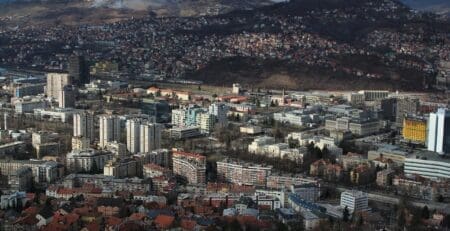The employment rate in Tr. 4 2023 in developed countries and in the Western Balkans
The employment rate in Tr. 4 2023 in developed countries and in the Western Balkans
OECD[1] employment and labour force participation rates remained broadly stable at 70.1% and 73.8% in the fourth quarter of 2023, the highest levels recorded since the start of the series in 2005 and 2008, respectively. Both indicators were at or near their record highs in 10 of the 38 OECD countries, including Italy and Japan (Tables 1 and 2).
In the fourth quarter of 2023, the employment rate exceeded 70% in almost two-thirds of OECD countries, including Canada, Germany, Japan, the United-Kingdom and the United States (Figure 1). The employment rate increased in 11 OECD countries and fell in 10 countries, with the largest declines observed in Colombia, Israel, and Luxembourg. Türkiye remained the OECD country with the lowest employment rate, at 54.2%, which was nevertheless its record high.
In 2023, the number of women and men in employment in the OECD area increased across all age groups (Figure 2) resulting in record high employment rates of 63.2% and 76.9% respectively. However, the gender gap narrowed as the OECD employment rate increased more rapidly among women (by 1.0 percentage point (p.p.)) than among men (by 0.3 p.p.). Turning to employment by age groups, the largest increase was recorded for older workers (aged 55 to 64), for whom the OECD employment rate reached 64%, showing an increase of 1.1 p.p. since 2022 and 10.5 p.p. since 2007. In 2023, the OECD labour force participation rate among workers aged 15 to 64 also reached its highest level of 66.6% for women and of 80.8% for men (Figure 3).
In February 2024, the unemployment rate remained broadly stable at 4.9% in the OECD area, remaining below or at 5.0% since April 2022. The unemployment rate remained at record lows in the European Union (6.0%) and the euro area (6.5%). It was unchanged in 16 OECD countries with available data, while 6 countries recorded increases and another 10 countries registered drops (Figure 4, Table 3). More recent data for March 2024 shows that the unemployment rate increased slightly to 5.4% in Canada, while it decreased to 3.6% in the United States. Nevertheless, the OECD youth unemployment rate (workers aged 15-24) peaked at 10.9% in February 2024, recording a pronounced increase of 0.5 p.p., with a marked rise in Colombia, Italy, Japan, and the United States.
Let’s see how the employment rate is in the Western Balkans[2]
In the fourth quarter of 2023 in Albania, the employment rate for the population aged 15-64 is 66.7%. During this quarter, the employment rate increased by 0.2 percentage points, compared to the same quarter a year ago, and decreased by 1.0 percentage points, compared to the third quarter of 2023.
The number of employees for the population aged 15 and over, from the fourth quarter of 2022 to the fourth quarter of 2023, has increased by 0.6%. In annual terms, employment decreased by 2.0% in the agriculture sector and by 0.1% in the industry sector, while it increased by 2.8% in the services sector.
Compared to the previous quarter, in the fourth quarter of 2023, employment for the population aged 15 and over decreased by 1.0%. Employment decreased by 1.3% in the agricultural sector and by 1.9% in the services sector, while it increased by 1.7% in the industry sector.[3].
The employment rate in Bosnia and Herzegovina increased to 42.40 percent in the fourth quarter of 2023 from 41.80 percent in the third quarter of 2023[4]. In 2023, the unemployment rate in Bosnia and Herzegovina decreased by 0.8 percentage points (-6.32 percent) since 2023. The unemployment rate thus reached its lowest value in recent years[5].
According to the data for the fourth quarter of 2023, in Montenegro there were 318.7 thousand active population, of which 279.9 thousand employed persons or 87.8%, and 38.8 thousand unemployed1, or 12.2%[6].
The employment rate in Macedonia has decreased to 45.40 percent in the fourth quarter of 2023 from 45.70 percent in the third quarter of 2023[7].
The largest decrease in employment was observed in the service activity (2,850 people or 0.7%), followed by the construction sector with a decrease in the number of employees by 2,294 people or 5.2% on a quarterly basis, while the industry sector and agriculture registered an increase in employment by 2,888 people (respectively 1.7%) and 741 people (1.1%).
Within the industry, the largest increase was recorded in employment in Processing (4403 persons or 3.2%), followed by Supply of electricity, gas, steam and air conditioning (690 persons or 9.1%), while a decrease in employment was observed in Water and Sewerage, waste management and repair activities (1,462 people or 9.8%), as well as mining and quarrying (743 people or 10.6%)[8].
The employment rate for the fourth quarter in Serbia reached 50.5%, while the unemployment rate, in the same period, was 9.1%.
It was somewhat lower compared to the 50.7% employment rate recorded in the third quarter.
The employment rate increased by 1.4 percentage points (p.p.) and reached 50.5%, while the unemployment rate was 9.1%, which represents a decrease of 0.3 p. page compared to the fourth quarter of the previous year. The activity rate increased and the rate of the population not in the labor force decreased by the same value of 1.3 p. page and reach respectively 55.6% and 44.4%[9].
[1] https://www.oecd.org/sdd/labour-stats/labour-market-situation-oecd-updated-april-2024.htm
[2] Kosovo has not yet published statistics on the employment rate for the fourth quarter of 2023
[3] https://www.instat.gov.al/media/13102/atfp-tr4-2023_press-release.pdf
[4] https://tradingeconomics.com/bosnia-and-herzegovina/employment-rate
[5] https://www.statista.com/statistics/453933/unemployment-rate-in-bosnia-herzegovina/
[6] http://www.monstat.org/eng/novosti.php?id=3899
[7] https://tradingeconomics.com/macedonia/employment-rate
[8] https://finance.gov.mk/wp-content/uploads/2023/06/Quarterly-Economic-Report-Q4-2022.pdf
[9] https://publikacije.stat.gov.rs/G2024/pdfE/G20241053.pdf




Leave a Reply
You must be logged in to post a comment.